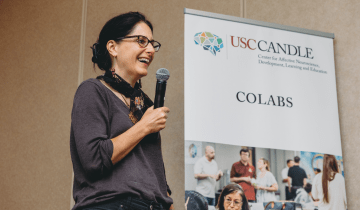How did your experience growing up in Detroit shape you?
Detroit is this amazing place that does an excellent job of nurturing children to be not just good people, but strong people. Proud people. Resourceful people. Every person you meet will have this special kind of resilience and strength. Not only are they going to fight through hard times, but they’ll have a joy about them while doing it.
Growing up in an all-Black city and going to predominantly Black schools helps you develop a sense of self, and a love for your Blackness that you can’t get when you grow up in places where you might be the only Black person. Being in a Black city profoundly shaped who I am, the research that I do. My sense of creativity and innovation with my research is all because I had this foundation.
As young as third grade, I was a part of the African History Club, and we learned so many academic and life skills. We hustled to make money to travel. In third grade, I was selling candy so I could travel to Philadelphia for a club field trip. I also had an opportunity to be the editor and a writer for our newsletter as I learned about my history and who I am.
My mom also provided a model for me that suggested I might be able to do whatever I put my mind to. If I wanted to play saxophone, my mom bought me a saxophone. I wanted to go to dance school—she paid for me to take ballet, tap and jazz. Whatever I wanted to do, she would make a way for me. She called me her little explorer. At the same time, when I started asking for her to buy me nicer clothes when I got older, she said I had to get a job and pay for them myself. So I started working when I was 15, but had to be sure to maintain good grades and a number of leadership roles in high school.
There’s a saying, “Detroit hustles harder.” We know we have to work harder than most people, be more creative with accomplishing our goals and bounce back faster when faced with obstacles.
The COVID-19 pandemic has shifted many schools online, which has exacerbated existing digital equity problems. What are some of the problems, and how has the pandemic made them even worse?
It’s been well-documented that across the country we have inequities with respect to access to devices and internet connection. A Pew Research Center study from 2018 showed that 25 percent of Black teens often or sometimes are unable to complete their homework because they do not have a device at home or an adequate internet connection. This is compared with about 13 percent of White teens and 17 percent of Latinx teens. My center conducted a survey of remote learning experiences in spring 2020 and saw similar findings. Though 94 percent of the sample of 11- to 19-year-olds had an internet connection, only 82 percent had a high-speed connection that allowed them to complete their schoolwork. Of those who reported not having sufficient high-speed internet access, 37 percent were Black, 27 percent were Latinx, 18 percent were White, 2 percent were biracial, 12 percent were East Asian and 3 percent were South Asian. When we look at cities across the country, we see similar patterns with engagement. Los Angeles Unified School District, for example, reported a 20-point gap in participation on the Schoology platform for Black and Latinx students compared with White students.
We also see problems on a host of other indicators, including exposure to challenging school materials. For example, our remote-learning survey showed White students found their schoolwork challenging more frequently than did Black students in the areas of English and math, and Latinx students in the areas of English, math, government and science. We’ve had similar findings with respect to participants seeing themselves represented in school materials. Whites are much more likely to endorse questions about representation across subjects than students of color.
"It’s also important to create an engaging learning environment, to give students assignments where they see themselves represented in the materials. Teachers have to give students space to talk about current events. Their lives should be a part of the curriculum." —Brendesha Tynes
Other troubling developments include the policing of Black and Brown bodies in online classrooms. There needs to be more research on this, but we’ve seen articles reporting students being disciplined for not engaging in remote learning, including not having their videos on. One teen in Michigan was sentenced to juvenile detention for not completing her assignments.
These are just a few problems on a very long list of inequities.
With looming budget cuts likely on the horizon, many school districts don’t have the resources to meet the moment. On the flip side, we’ve seen technology companies report record-breaking profits as our reliance on their technologies has substantially increased. What do you think it would take—both in financial terms and strategically—for schools to be equipped to operate online, and do you see a role for tech companies to play?
We need a complete reimagining of schools. Right now, we are just taking the old and putting it online and doing poorly at that. We need funding for current and emerging technologies. Teachers need funding to learn how to work the technology as well as how to promote academic and social-emotional learning while using digital tools.
This reimagining would require a new type of teacher: one who has extensive training in how to be anti-racist. A teacher who engages in anti-racist, culturally sustaining practices. This reimagining would not only include teachers trying to read more about race and racism and develop their own sense of self, but also deep reflection on students’ strengths and how they can leverage them in the classroom. We’ll have to revamp inequitable policies and textbooks that inadequately and inaccurately represent Black and Indigenous people. Students should be encouraged to create their own technologies, but instead we’re concerned with whether their cameras are on and how well they can complete an electronic worksheet.
In this reimagining, tech companies can do more than just profit. They can pay their share of taxes. They can donate devices and internet access to those most in need. They can create pathways for access to tech jobs. I don’t think tech companies need to be directly involved in formal education, because they just reproduce a lot of the inequity that’s built into the technologies they create.
What are some of your current research projects, and how has the pandemic affected your work?
We have a project on anti-racist remote and online learning where we are looking at what middle, high school and college students say about their experiences during the pandemic, including their sense of online community: whether they were represented in the materials online, the quality of the work they were assigned, whether they had to just do worksheets instead of more meaningful kinds of activities that are culturally sustaining or interest-driven.
There’s also the Lyle Spencer Award to Transform Education. It’s a first-of-its-kind, nationally representative, longitudinal online survey of 11- to 19-year-olds’ critical digital literacy skills. We’re specifically trying to understand participants’ general skills, as well as how they are able to critique race-related material. We’ve had to develop the digital literacy assessments we’re going to use along with new scales because there are none that exist that account for the skills young people need to navigate a post-2020 digital landscape.
Viral videos of Black men and women dying at the hands of police ignited the Black Lives Matter movement, and you’ve been studying the impact of these videos on Black and Brown youths. What are your findings so far?
We’re finding among a sample of Latinx and Black students between ages 11 and 19 that exposure to viral videos and images of police racial violence—and that includes seeing immigrants in cages, seeing police killings—is associated with PTSD. We are currently analyzing data to help us understand whether police racial violence or online racial discrimination is also associated with suicide ideation. This is the first study, to my knowledge, to explore these associations. The idea is to use our pilot data to get funding to further examine the role of technology in Black youth suicide, as there’s been a dramatic increase.
"Once we deal with anti-Blackness, and we allow more of these Black, brilliant minds to create technologies, we will see technology live up to what people claimed it would be early on." —Brendesha Tynes
Is there any particular advice you would give to parents?
The No. 1 thing is to keep open lines of communication where their children feel safe to talk about what’s happening online, and to talk about how they’re feeling in general. You want to be sure that you’re watching for changes in appetite or weight, crying spells, inability to concentrate and feelings of overwhelming sadness or emotional numbness. You want to monitor their physical and emotional state and make sure if they persist that you consider getting a culturally competent therapist who understands racial trauma.
Teachers have to understand that experiencing police racial violence on top of the pandemic is traumatic. Seeing people from your racial group being killed and knowing that you could be next is traumatic. I marvel at people who are still able to get work done when more Black and Brown people are dying from COVID and more people of color know someone who’s died. And then, on top of that, you have the threat of violence from police officers and White supremacists. Teachers, parents, community members—we all need to be aware and, as much as we can, provide support for children and for other adults.
With a lot of educators now teaching online, they don’t have in-person interaction with students. Is there anything that you’d suggest they look out for?
If they have a new class, it’s going to be important for them to get to know their students as individuals and know something about their parents or families and their cultures. It’s important to have one-on-ones with the kids and families to get to know their strengths and interests. The more you know about this amazing human being sitting in front of you, the more you can anticipate and recognize their needs, even if it’s through the screen.
It’s also important to create an engaging learning environment, to give students assignments where they see themselves represented in the materials. Teachers have to give students space to talk about current events. Their lives should be a part of the curriculum. We also need more mental health staff so students will be able to connect with a culturally competent therapist if they are having problems.
Are there any recent technological advances that you’re excited about in terms of their potential to be used in education?
Yes, one of my own apps that we’re working on. It’s called CRITmetic, and it’s designed to teach kids to think critically about general and race-related messages they encounter online. It gives them a toolkit to critique and evaluate a range of digital materials. There’s actually nothing out there—not a single program—that would prepare kids for this post-2016 landscape that specifically targets Black people and conservatives. This app would help them to recognize how foreign countries can spread misinformation for economic and political ends.
We thought technology was going to make the world more equitable, but we haven’t seen that yet. Do you think we ever will?
I think once we deal with anti-Blackness, and we allow more of these Black, brilliant minds to create technologies, we will see technology live up to what people claimed it would be early on. But you have to let Black people compete, give them equal opportunities and watch how the field is transformed.





